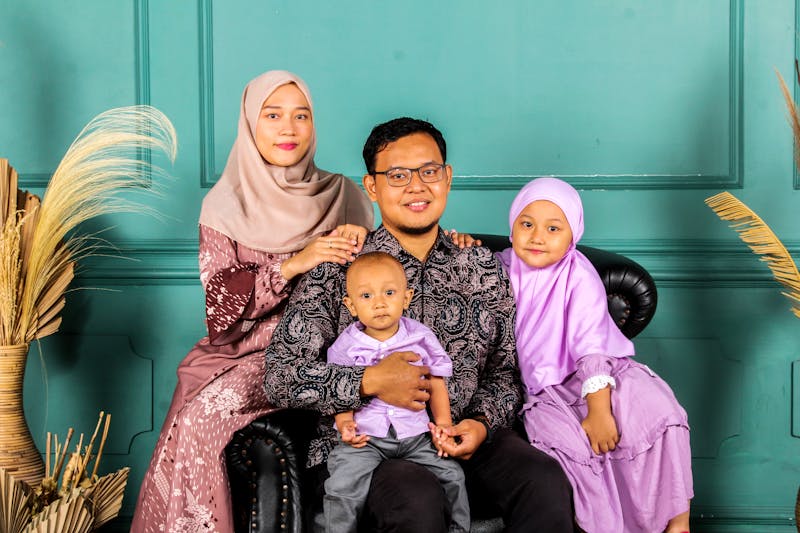Can I Include My Spouse and Children in My Asylum Application?

The U.S. immigration system has specific provisions for family members of asylum seekers, but the rules are complicated and often misunderstood. At the Law Office of Lina Baroudi, we frequently work with immigrants seeking protection who want to ensure their loved ones are also protected.
This article explains who qualifies as a derivative asylum beneficiary, how to include family members in your asylum application, and what to do if your family members are outside the United States.
Who Can Be Included in an Asylum Application?
If you’re applying for asylum in the United States, you may include the following family members:
- Your spouse (if you were legally married before a decision is made on your asylum application)
- Your unmarried children under 21 years of age
These family members can receive “derivative asylum status,” which means they derive protection through your asylum application without having to prove their own persecution claims.
Including Family Members Who Are in the United States
If your spouse and children are already in the United States with you, the process for including them is relatively straightforward:
1. List Them on Your Form I-589
When completing your asylum application (Form I-589), you must list your spouse and all children in the appropriate sections of the form. This includes:
- Part A.II for your spouse’s information
- Part A.III for your children’s information
Simply listing your family members on your asylum application doesn’t automatically grant them asylum status—you must provide adequate documentation to establish your family relationship.
2. Submit Required Documentation
For each family member, you must provide:
- For your spouse: Marriage certificate and evidence that any previous marriages were legally terminated
- For your children: Birth certificates showing both the child’s name and your name as the parent
- Passport-style photographs for each family member
- Copies of their I-94 Arrival/Departure Records (if they have them)
- Copies of passports or other identity documents
If these documents are in a foreign language, you must include certified English translations.
3. Include Family Members in Asylum Interviews or Hearings
Family members listed on your application should generally attend:
- Your asylum interview (if filing affirmatively with USCIS)
- Your court hearings (if in removal proceedings before an Immigration Judge)
When you’re granted asylum, your spouse and unmarried children under 21 who were properly included on your application will also receive asylum status, provided they were physically present in the United States and the relationship existed at the time you filed for asylum.
What If My Family Members Are Outside the United States?
Many asylum seekers are forced to leave family members behind when fleeing persecution. If your spouse or children are still outside the United States when you apply for or receive asylum, you cannot include them on your initial application, but you can petition for them afterward.
Filing Form I-730 (Refugee/Asylee Relative Petition)
Once you’ve been granted asylum, you can file Form I-730 to bring your spouse and unmarried children under 21 to the United States. Important requirements include:
- You must file within 2 years of being granted asylum (with limited exceptions for humanitarian reasons)
- The family relationship must have existed before you were granted asylum
- You must file a separate I-730 petition for each family member
- There is no filing fee for Form I-730
The required documentation is similar to what’s needed for including family members on your initial application—proof of your asylee status, evidence of the family relationship, and photographs of your family members.
Processing of Family Members Abroad
After USCIS approves the I-730 petition:
- The petition is forwarded to the National Visa Center, then to the U.S. embassy or consulate with jurisdiction over where your family member resides
- Your family member will be contacted for an interview
- Following approval, they will be issued travel documents to come to the United States
- Upon arrival, they’ll be admitted as derivative asylees
Understanding the Child Status Protection Act (CSPA)
One of the most challenging aspects of derivative asylum is the “aging out” problem—children who turn 21 before the asylum process is completed may lose eligibility. Fortunately, the Child Status Protection Act provides some protection:
- For children included on your asylum application, their age is “frozen” on the date you file your asylum application
- If your child was under 21 when you filed for asylum, they remain eligible for derivative status even if they turn 21 during the asylum process
- For I-730 petitions, different rules may apply depending on whether your child was included on your application and your child’s marital status
This is a complex area of immigration law, and specific circumstances can affect eligibility, so it’s advisable to consult with an immigration attorney if your child is approaching age 21.
Special Scenarios for Family Members of Asylum Seekers
Stepchildren
If you’re seeking to include stepchildren in your asylum application or I-730 petition:
- The marriage creating the step-relationship must have occurred before the child turned 18
- You must provide evidence of the marriage to the child’s biological parent
- You may need to provide evidence of a genuine parent-child relationship
Adopted Children
For adopted children:
- The adoption must have been completed before the child turned 16
- You must have had legal custody of and lived with the child for at least two years
- You must provide official adoption documentation
Proving Relationships When Documentation Is Limited
Asylum seekers often flee without important documents. If you can’t provide primary evidence of relationships (like birth or marriage certificates), you may submit secondary evidence such as:
- Religious institution records
- School records
- Census records
- Affidavits from people with personal knowledge of the relationship
- In some cases, DNA testing may be recommended or required
What Derivative Asylum Status Means for Your Family
When your family members receive derivative asylum status, they:
- Can legally remain in the United States
- Are eligible to apply for employment authorization
- Can apply for a Social Security number
- Can travel outside the U.S. with a Refugee Travel Document (though travel to the country of feared persecution is generally discouraged)
- Can apply for permanent residence (a green card) one year after being granted asylum
- Cannot confer derivative status to their own family members (for example, your child cannot petition for their spouse)
The Two-Year Filing Deadline for I-730 Petitions
If your family members are outside the United States, remember that you must file the I-730 petition within two years of being granted asylum. This deadline is strictly enforced, with limited exceptions for humanitarian reasons.
If you miss this deadline, your options for bringing family members to the United States become much more limited and typically involve longer wait times. You would need to:
- Apply for permanent residence (after one year in asylum status)
- Once you have your green card, file family-based immigrant petitions (Form I-130)
- Wait for visa availability in the appropriate family preference category
This alternative process can take many years, especially for certain countries with significant visa backlogs.
Recent Changes to I-730 Processing
As of May 2024, USCIS has made changes to how certain I-730 petitions are processed. All Following-to-Join Refugee (FTJ-R) petitions are now processed by the USCIS International Operations Division rather than the Asylum Vetting Center.
This change aims to improve efficiency and processing times by establishing a dedicated team for these petitions. Any pending FTJ-R petitions are being automatically transferred, and petitioners should receive transfer notices with updated information.
Challenges and Considerations
Several challenges may arise when seeking to include family members in asylum applications:
Marriage After Asylum Decision
If you marry after a decision is made on your asylum application, your spouse cannot be included as a derivative on your application. You would need to wait until you’ve become a permanent resident and then file a family-based petition.
Divorce
If you divorce your spouse after being granted asylum but before your spouse receives derivative status, they will no longer be eligible for derivative asylum.
Children Marrying Before Admission
If your unmarried child marries before being admitted to the U.S. as a derivative asylee, they will lose eligibility for derivative status.
Security and Background Checks
All family members undergo security and background checks. Serious criminal convictions or security concerns may make them ineligible for derivative status.
Getting Legal Help for Family Members of Asylum Seekers
The process of including family members in asylum applications or petitioning for them after receiving asylum involves complex legal requirements and strict deadlines. Mistakes can lead to delays or denials that keep families separated for years.
At the Law Office of Lina Baroudi, we understand the critical importance of family unity for asylum seekers. We can help you navigate the process of including family members in your asylum application or filing I-730 petitions for family members abroad.
The U.S. immigration system doesn’t make family reunification easy, but with proper legal guidance, you can maximize your chances of protecting your loved ones through the asylum process.
If you’re preparing an asylum application or have been granted asylum and need to petition for family members, contact our office to discuss your specific situation and develop a strategy for keeping your family together.



